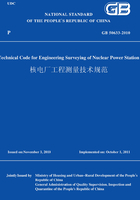
3.4 Low-water Survey
3.4.1 Before site survey,the hydrographic map of drainage areas,the topographic map of drainage areas and river reaches to be surveyed,data from hydrological stations,the characteristics of drought occurring in the drainage areas and the water recharge sources,relevant historical documents,relics and low-water survey reports,current status and planning of industrial,agricultural(animal husbandry),urban and ecoenvironmental water,and current status and planning and operation scheduling scheme of hydraulic projects shall be collected.
3.4.2 For the historical low-water survey,the following information shall be collected:the occurrence time,causes,durations and recurrence intervals of severe droughts;low-water level marks and water depth,drought area,water recharge sources,drought and water condition when the drought occurs,drought process and continuous drought;influences of human activities;the composition of riverbed material and the condition of river sections;main river channel change,and scouring and silting of river bed and river banks.
3.4.3 The historical low-water survey should be conducted in dry seasons,and the survey results obtained in other periods shall be reviewed in dry seasons.The return amount of surface water such as irrigation water shall be particularly surveyed,and whether there is dry-up shall be determined.
3.4.4 The upstream and downstream extent of historical low-water survey shall be determined according to the requirements for ascertaining low-water information and estimating low water flow.If necessary,severe droughts of adjacent rivers shall be surveyed for comparative analysis.
3.4.5 The low-water survey shall be conducted in well controlled river reaches with low-water marks that can be surveyed easily,with straight watercourse,stable flow,slight scouring and silting,and less effect of human activities.
3.4.6 The historical low-water marks can be surveyed based on permanent buildings or facilities of water resource,harbor and transportation authorities,river banks where residents collect water,and fishery condition.The occurrence time and duration of low water shall be analyzed and determined according to important historical events and those impressive to local residents in conjunction with collected historical records.
3.4.7 For historical low water level survey,more than three low-water marks shall be surveyed for one dry season.The low-water marks are classified into three types based on their reliability:reliable,relatively reliable,and informative.The classification criteria include whether the occurrence of low water is witnessed,whether the description is exact,whether the supporting evidences are sufficient and sound,and whether the low-water marks are fixed.
3.4.8 For low-water survey in karst areas,the water recharge sources and the distribution and water quantity of riverbed seepage shall be identified and shall be observed if necessary.